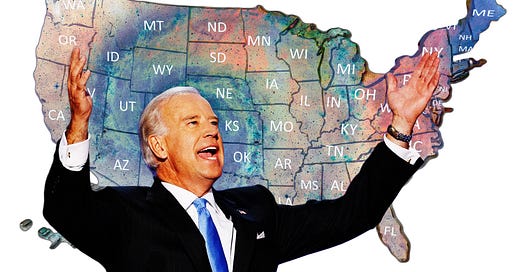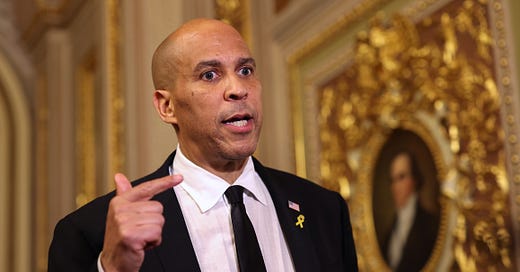
Joe Biden is now the presumptive Democratic nominee. Barring some very large, unexpected event, he will be his party’s standard bearer against Donald Trump in November.
The race is not fully over, but we’ve progressed to the endgame. As of Wednesday morning, Biden will have a slight delegate lead over Bernie Sanders in a spot where his glide path required only that he not be trailing by more than 150 (or so) delegates. Over the next two weeks, Biden will win overwhelming victories in Florida and Mississippi. He is likely to win in Ohio, Arizona, Illinois, and Missouri. A week after that, he will win a large victory in Georgia.
As things stand now, no one else has a path to a majority of the delegates and Biden’s principal rival is a socialist who does not identify as a Democrat, is heading into difficult demographic terrain, and—most importantly—is fading, rather than surging.
Meanwhile, Biden remains the vice president to the most recent Democratic president, a two-termer who remains immensely popular both with the public at large and the Democratic base. Biden has been in politics for 50 years and during this cycle has endured a campaign in which each of his Democratic rivals took a blowtorch to him, Republican office-holders across the land spent money advertising against him, and the president of the United States risked impeachment in an effort to blackmail a foreign government into trying to damage his electoral prospects.
I do not believe that any nominee in modern times has been as aggressively opposed during the primaries—both by his or her own intra-party rivals as well as the opposition party, including a sitting president.
The very fact that Biden is sitting where he is after Super Tuesday—where the map was still not especially favorable to him—should say something about his raw electoral strength.
I’ve spent much of the last seven months telling everyone who would listen that it was crazy to sleep on Joe Biden and that there was a reason Biden’s opponents were so afraid of him.
So let’s settle all family business, right now, with some lessons that people should glean from the Super Tuesday results.
(1) The lanes are real. Here is something I was not right about: I always thought that the “lane” theory of primaries was a mistake, that the lanes only existed in the heads of campaign managers. I believed that voters behave in weird and unpredictable ways and that you don’t need to fixate on winning your lane—you need to fixate on winning votes.
The results we’ve seen in this race since Nevada suggest that the lanes were real. Sanders owned the progressive lane while Biden, Pete Buttigieg, and Amy Klobuchar were splitting the moderate lane. When Mayor Pete and Klobo dropped out, the consolidation moved overwhelmingly to Biden.
But I would add an important caveat: Even if the lanes are real, campaigns should pretend they aren’t.
Iowa and New Hampshire were always going to be tough states for Biden. But unlike campaigns in past cycles that simply declined to play in the early states where they thought they would perform badly, Biden competed, hard. He played to win, even though the main body of voters in those states were outside his lane.
In this way, Biden’s campaign actually resembled Donald Trump’s 2016 primary strategy: Trump never bought into the idea that he couldn’t win in a hostile environment. And neither did Biden.
So what if the truth about lanes is that they exist, but that campaigns have to pretend that they don’t? Because to configure your campaign so that you only look to win your lane is to commit to certain death . . .
(2) Bernie’s theory of the election has been disproven. The Sanders view of 2020 was that the enthusiasm for radical change and dissatisfaction from within the base of the Democratic party would motivate an entire new class of non-voters to show up and elect an outsider.
This has not happened. Turnout in Iowa (which Sanders lost) was quite low. Turnout in New Hampshire (which Sanders won by a nose) set a record—but not by a huge margin. Turnout in Virginia really did surge: there were 780,000 voters in 2016, 1.3 million people showed up on Tuesday.
But that surge of people wasn’t for Bernie. Even with turnout almost doubled, Sanders only picked up an extra 30,000 votes over his 2016 figure. Almost as many people voted for Biden in 2020 as voted—total—in 2016.
At the risk of sounding callous, these results suggest that, had he become the nominee, Sanders would have had a great deal of difficulty in the general election, because his new-voter army had not yet appeared.
(3) Elizabeth Warren is a terrible candidate. Warren was the first major candidate in the race—much respect, John Delaney—and she spent months getting no traction as a vehicle for reform. So she decided to become the progressive darling, even though it meant entering into a bidding war against an actual socialist. Which was an unwinnable proposition.
Over the course of her many months she was a media and Twitter favorite, but generated very little goodwill with actual voters. She flipped on health care—the single most important policy issue for Democratic voters—not once, but twice. Over the last two weeks she openly auditioned to be Bernie’s running mate, thus spurning candidates from her party in favor of a socialist interloper.
On Super Tuesday she finished third in her home state, getting beat by Joe Biden. Like a drum.
(4) Bernie Sanders finally got a hard look from Democrats. The Biden surge was really a harmonic convergence of three separate wave patterns:
The change in demographic terrain to states with non-trivial percentages of African-Americans.
The consolidation of the field.
A three week period during which Bernie Sanders was finally taken seriously by Democratic primary voters.
For a guy who almost won the nomination four years ago and was a rock-solid second throughout this cycle, Sanders never got the respect he deserved as a candidate. One sign of respect is a willingness on the part of both the media and voters to take you seriously as a possible president and perform, at the very least, an eye test.
Over the last three weeks, Sanders failed the eye test.
This is precisely what happened to Elizabeth Warren last fall. Think back to October, when Warren briefly eclipsed Sanders as the second-place candidate. But over a period of four weeks, a combination of swing-state polling and scrutiny of her Medicare for All plan sent her into a spiral from which she never recovered.
Now look at the late-deciding voters across the board on Super Tuesday:

This is what happens when a candidate doesn’t get a close-up until the voting is already in-process.
(5) Hugh Hewitt is a very astute observer of politics whose predictions merely happen to align with his personal preferences which, by total coincidence, happen to align with what his radio audience wants to hear.




(6) Donald Trump’s Ukraine gambit was probably a smart play. Look at the crosstabs: Biden’s strengths are problematic for Trump.
Biden is obviously going to turn out black voters. But he’s also enormously strong with the college-educated suburban women who helped power the Democrats’ 2018 takeover of the House. And he shows significant strength with white voters without college degrees, too.


That’s the trifecta Democrats need to beat Trump in November. But it’s also the foundation of a realistic path to expanding their House majority and taking over the Senate.
For a year, Donald Trump and the Republican party have tried everything within their power—both legal, and extra-legal—to avoid having to face Joe Biden. That was a rational calculation and just because the gamble didn’t pay off doesn’t mean it wasn’t worth taking.











